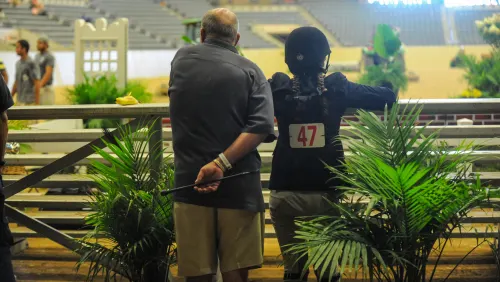To the uninitiated, a day of foxhunting may seem like one of life’s great mysteries. Everyone awakes at unimaginable hours, dresses in strange uniforms, and gathers together to follow a pack of hounds across the countryside. There’s an arcane language unique to foxhunting, numerous unspoken rules, and even more mysterious social protocol to follow. One can imagine that, even for an experienced horseman, a day following the hounds may seem daunting.
Caitlin Rollins’ article in this Hunt Roster issue (“The Answers To Questions People Are Afraid To Ask Before They Go Foxhunting,” p. 8) takes a light-hearted and amusing look at some of the basic elements a brand-new foxhunter might want to know. Of course, a little serious research into the customs and rules would be wise before venturing out for your first day hunting, but Rollins gives us some whimsical answers to many questions. And other articles in the issue make it clear that a rousing day behind hounds can be fun for just about anyone.
Our Horse Of A Lifetime story about Tonto (p. 16) shows that you don’t need an imported Irish foxhunter who has cut his teeth on Limerick’s stone walls to hunt safely. Any horse who has a good mind, safe jumping technique and a desire to stay upright can take you hunting. And the horse you may have deemed least likely to hunt might just surprise you with his turn of foot, bravery and sensibility. They don’t have to be dappled gray, huge and named Laddy to hunt well.
In fact, June Brigman (p. 32) doesn’t even own a hunting horse. She’s worked out a mutually beneficial arrangement with the master of her local pack to be able to hunt horses in exchange for exercising them. Brigman only started riding in her 20s and began hunting at age 33. She’s been an avid follower of the hounds ever since, and she proves that you can start your love of hunting at any age.
ADVERTISEMENT
Donna Ross’ article “Foxhunters Have Begun Their Own Brand Of Succession Planning” (p. 42) discusses the strategies that different hunts are using to attract new staff and members. And James Scharnberg’s piece “Hounds Steal The Show At Ludwig’s Corner” (p. 38) describes how one Basset pack is reaching out to its community about hunting and conservation issues.
This issue shows that hunting doesn’t always live up to its worst stereotype. It’s not just for the elite or the well-connected riding Irish-bred horses. It’s a sport that anyone can enjoy, one way or another. If you’re interested in going out hunting for a day, look in our Hunt Roster to get in touch with one of your local hunts and find out how. Few people are as passionate and fervent about their sport as foxhunters, and they’re usually more than willing to infect others with their passion.
With the battle that continues to rage in England over the House of Commons’ vote to ban foxhunting, it’s all the more important that U.S. hunts seek to promote themselves in the best light possible and appeal to as wide a range of enthusiasts as they can. This issue proves that everyone in the hunting field has gotten there a different way, with different goals, and by different means. The bottom line is the love of the chase, and the way the heart jumps when the hounds begin their cry.














